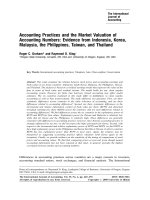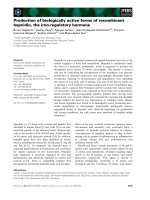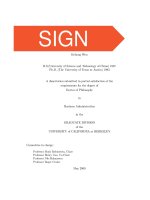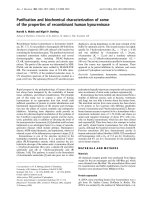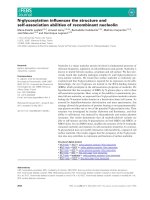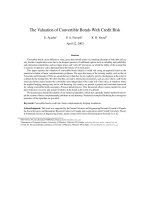Valuation of the safety of recombinant adenovirus coding human IL-12 protein on mice
Bạn đang xem bản rút gọn của tài liệu. Xem và tải ngay bản đầy đủ của tài liệu tại đây (225.32 KB, 6 trang )
Journal of military pharmaco-medicine no8-2019
EVALUATION OF THE SAFETY OF RECOMBINANT
ADENOVIRUS CODING HUMAN IL-12 PROTEIN ON MICE
Nguyen Thai Bieng1; Hoang Quoc Truong2; Dang Quang Chung3; Ho Anh Son 1
SUMMARY
Objectives: To evaluate the safety of recombinant adenovirus coding the human IL-12
protein in mice. Subjects and methods: BALB/c mice were divided into 3 groups, each group of
9 mice, including control group, recombinant adenovirus coding the human IL-12 protein
6
injection group at 10 vp/head, recombinant adenovirus coding the human IL-12 protein injection
7
group at 10 vp/head. Mice were monitored for general health, liver and kidney function, and
tested for the presence of recombinant adenovirus coding the human IL-12 protein in mouse
organs. Results: Recombinant adenovirus coding the human IL-12 protein injected mice were
healthy, no dead mice. Hepatic and renal function showed no significant difference through
ALT, AST, bilirubine, urea and creatinine. Recombinant adenovirus coding the human IL-12
protein was not found in rat organs by PCR technique. Conclusion: Recombinant adenovirus
7
coding the human IL-12 protein is safe for mice at dose of 10 vp/head.
* Keywords: Adenovirus; IL-12; Recombinant adenovirus coding the human IL-12 protein; Mice.
INTRODUCTION
Interleukine-12 (IL-12) is one of the
promising cytokines in anti-cancer
immunotherapy. IL-12 activates and
triggers type 1 support T cells (Th1),
stimulates differentiation of toxic T cells
(TCD8+); promotes T-cells to maintain the
production of interferon-gamma (IFN-γ)
which is necessary for tumor suppression;
directly affecting natural killer cells to kill
cancer. In addition, IL-12 also has an
indirect anti-vascular genesis through
intermediate proteins such as IP-10 and
Mig induced by IFN-γ. The recombinant
adenovirus vector coding IL-12 protein
is a product of the national project
"Researching on the application of the
interleukine-12 protein for the treatment of
hepatocellular carcinoma", integrating the
3rd generation Ad vector and IL-12-encoded
gene has been shown to transfer into liver
cancer cells, as well as produce IL-12 in
vitro. To be able to use in the next study,
we conducted an assessment of safety of
this preparation on experimental animals.
SUBJECTS AND METHODS
1. Subjects.
- BALB/c mice were kept in a laboratory,
cared as guidance at the Institute of
Biomedicine and Pharmacy, Vietnam Military
Medical University.
1. Vietnam Military Medical University
2. 108 Military Central Hospital
3. Viet Tiep Hospital
Corresponding author: Ho Anh Son ()
Date received: 19/09/2019
Date accepted: 18/10/2019
120
Journal of military pharmaco-medicine no8-2019
- Recombinant adenovirus coding IL12 protein (Ad-IL12) and recombinant
adenovirus (Ad), provided by Department
of Molecular Biology, 108 Military Central
Hospital.
2. Material and equipment.
- Group 3 (control): sodium chloride
0.9% x 0.20 mL/mouse, tail vein injection,
single dose.
* Assessment of safety of Ad-IL12:
- Body condition, body weight, death,
stool and other abnormalities.
Primer pORF-IL12 forward, 5’-TGGGAG
TACCCTGACACCT-3’ and pORF-IL12
reverse, 5’-GTACCCCTACTCCAGGAAC3’ for IL-12 detection.
- Assess liver and kidney function:
Determine the activity/concentration of
AST, ALT, total bilirubine, urea, creatinine
in serum (1 week after injection).
Gel-Doc & Dolphin (gel) scanner,
electrophoresis kit (Bio-RAD), PCR 9700
(Applied BioSystems), centrifuge (Beckman),
spectrophotometer (Beckman), thermal
block machine (Eppendorf).
- Discover genetic material of Ad-IL12
in mouse organs by PCR (after 3 weeks
of injection). PCR reaction was optimized
as follow: 12.5 mcL 2X PCR Master mix;
10 pM forward and reverse bait; 5 mcL
total DNA; add sterile water to 25 mcL.
The thermal cycle for PCR: 95oC,
5 minutes; 35 cycles [95oC, 20 seconds;
58oC, 30 seconds; 72oC, 1 minute]; 72oC,
5 minutes; keep heat at 4oC. The product
of PCR reaction was captured on
1% agarose gel.
3. Research methods.
The mice were randomly divided into
3 groups, 9 mice per group:
-.Group 1: Ad-IL12 at dose of 106 vp/
mouse, tail vein injection, single dose.
- Group 2: Ad-IL12 at dose of 107 vp/
mouse, tail vein injection, single dose.
RESULTS
1. Body condition of mice during the experiment.
After Ad-IL12 administration, the mice were still eating and operating normally, agile,
smooth hair, clear eyes, and dry anus. There were no signs of abnormalities such as
ruffled feathers, bleeding, loose movement, seizures, etc. No mice die was observed.
Table 1: Mice body weight.
Group
Body weight (g)
n
Day 0
Day 7
6
9
22.4 ± 1.12
23.2 ± 0.88
7
Group 2 (10 vp/head)
9
22.1 ± 1.15
22.8 ± 0.96
Group 3 (control)
9
22.3 ± 1.28
23.2 ± 1.0
Group 1 (10 vp/head)
The mice still gained weight during the experiment. Thus, Ad-IL12 at the two studied
dose levels did not affect the systemic status of the mice.
121
Journal of military pharmaco-medicine no8-2019
2. Results of biochemical tests of liver and kidney function.
Table 2: Results of AST activity in mice.
Group
n
AST activity (U/L)
6
Group 1 (10 vp/head)
6
195.5 ± 26.87
7
Group 2 (10 vp/head)
6
176.9 ± 33.23
Group 3 (control)
6
187.1 ± 14.48
p
> 0.05
Ad-IL12 at both dose levels (106 and 107 vp/mouse) slightly increased blood AST
enzyme activity in mice. However, there was no statistically significant difference in
blood activity of AST enzyme (U/L) among study mice groups.
Table 3: Results of ALT activity in study mice.
Group
n
ALT activity (U/L)
6
Group 1 (10 vp/head)
6
33.0 ± 5.57
7
Group 2 (10 vp/head)
6
43.3 ± 27.5
Group 3 (control)
6
27.7 ± 8.21
p
> 0.05
The serum ALT (U/L) activity was kept in normal limits in three groups. Thus,
Ad-IL12 at the two studied dose levels (106 and 107 vp/mouse) did not affect the mice
serum ALT activity.
Table 4: Results of total bilirubine in study mice.
Group
n
Total bilirubine (mcmol/L)
6
Group 1 (10 vp/head)
6
33.7 ± 14.75
7
Group 2 (10 vp/head)
6
51.0 ± 19.87
Group 3 (control)
6
41.9 ± 16.67
p
> 0.05
The difference in total serum bilirubine in the experimental mice was not statistically
significant compared to the control group.
Table 5: Results of urea concentration in study mice serum.
n
Urea (mmol/L)
6
Group
6
6.7 ± 1.67
7
Group 2 (10 vp/ head)
6
7.2 ± 1.85
Group 3 (control)
6
6.3 ± 1.06
Group 1 (10 vp/head)
p
> 0.05
The urea concentration in experimental groups was within normal limits. Thus, Ad-IL12
injection did not have significant effect on urea concentration in experimental mice.
122
Journal of military pharmaco-medicine no8-2019
Table 6: Results of creatinine concentration in study mice serum.
Group
n
Creatinine (mcmol/L)
6
6
45.1 ± 8.72
7
Group 2 (10 vp/head)
6
36.9 ± 12.8
Group 3 (control)
6
48.7 ± 11.7
Group 1 (10 vp/head)
p
> 0.05
The creatinine concentration in experimental group was within normal limits. Thus,
Ad-IL12 injection did not have significant effect on creatinine concentration in
experimental mice.
3. Results of PCR product amplifying IL-12 specific gene in mouse organs
after intravenous Ad-IL12 injection.
Figure 1: The results amplify IL-12 gene segments from total DNA extracted from organ
samples of mice.
(Group: 1 (A), 2 (B) and control group; liver (G), heart (Ti), striated muscle (Muscle),
lung (P), brain (N), kidney (Th) and serum (M); samples (-), negative PCR; sample (+),
positive plasmid)
123
Journal of military pharmaco-medicine no8-2019
No human gene segment encoding
IL-12 was detected in organs: heart, liver,
lung, kidney, brain, skeletal muscle, serum
in mouse groups injected with Ad-IL12,
compared with non-injected control group.
Thus, Ad-IL12 with 2 injection doses did
not develop, replicated in mouse tissues
and organs.
DISCUSSION
Ad-IL12 does not alter biochemical
indices that reflect renal and hepatic
function. The mice that were injected with
Ad-IL12 were still functioning normally,
not dead and still growing steadily.
Amplified reactions for the gene encoding
IL-12 was not detected in the heart, liver,
lungs, kidneys, brain, striated muscle, and
serum in Ad-IL12 injected mice. When
injecting animals with early generation
Ad vector (1, 2) results in late toxicity,
occurring 1 day to several weeks due to
the low level expression of viral proteins
from the vector backbone. With 3rd generation
Ad (Helper-dependent Adenovirus, HDAd),
toxicity appeared only 24 - 48 hours after
injection due to absence of virus expression
genes. The use of HDAd has brought
advantages in therapy, while limiting the
toxicity of many toxic gene segments on
adenovirrus. With the purpose of designing
to optimize the immune response and further
improve the safety of the Adenovirus
vector, the HDAd vector system was
generated. The designed vector was
removed all gene sequences carrying the
virus code (ie, eliminate all virulent genes
124
of the virus). The entire deleted gene
sequence of the virus will be replaced by
a gene carrier design or a non-coding
DNA sequence called "stuffing", to keep
the vector of the appropriate size for
packaging. The elimination of viral genes
strongly reduced the host's cytotoxic
response [1, 2, 3].
A study by Ng et al showed that this
third-generation vector was safer and the
toxicity significantly decreased when high
doses were used in mice [4]. In addition,
low-level lipoprotein receptors using HDAd
vectors have been produced for long
periods to combat atherosclerosis in rat
models with a history of hypercholesterolemia
that have been mentioned in Nomura et
al’s study [5]. In addition, this vector is
also used in ex vivo technology by
introducing the cystic fibrosis gene
through the sweat glands into the human
body for high gene transfer efficiency [6].
The production of recombinant Helperdependent Adenovirus virus carrying and
transmitting therapeutic genes that can
infect target cells with high efficiency,
good quality eliminates the contamination
of the helper virus being further optimized
to have get recombinant virus products
that carry safe therapeutic genes.
CONCLUSSION
Administration of Ad-IL12 at doses of
10 and 107 vp/mouse did not cause
changes in kidney and liver function. AdIL12 was undetected in mice organs by
PCR technique.
6
Journal of military pharmaco-medicine no8-2019
REFERENCES
1. He X.X, Chang Y, Meng F.Y, Wang M.Y,
Xie Q.H, Tang F, Li P.Y, Song Y.H, Lin J.S.
MicroRNA-375 targets AEG-1 in hepatocellular
carcinoma and suppresses liver cancer cell
growth in vitro and in vivo. Oncogene. 2012,
31, pp.3357-3369.
malignancies. Clin Cancer Res. 2002, 8 (11),
pp.3383-3393.
4. P.P. Cre levels limit packaging signal
excision efficiency in the Cre/loxP Helperdependent
Adenoviral
vector
system.
Journal of Virology. 2002, 76, pp.4181-4189.
2. Nicola Brunetti-Pierri et al. Helperdependent Adenoviral vectors for liver-directed
gene therapy. Hum Mol Genet. 2011, 20 (1),
pp.1-28.
5. Nomura S. Low-density lipoprotein
receptor gene therapy using helper-dependent
Adenovirus produces long-term protection
against atherosclerosis in a mouse model of
familial hypercholesterolemia. Gene Therapy.
2004, 11, pp.1540-1548.
3. Robertson M.J et al. Interleukine
12 immunotherapy after autologous stem
cell transplantation for hematological
6. Palmer D et al. Improved system for
helper-dependent adenoviral vector production.
Molecular Therapy. 2003, 8, pp.846-852.
125
